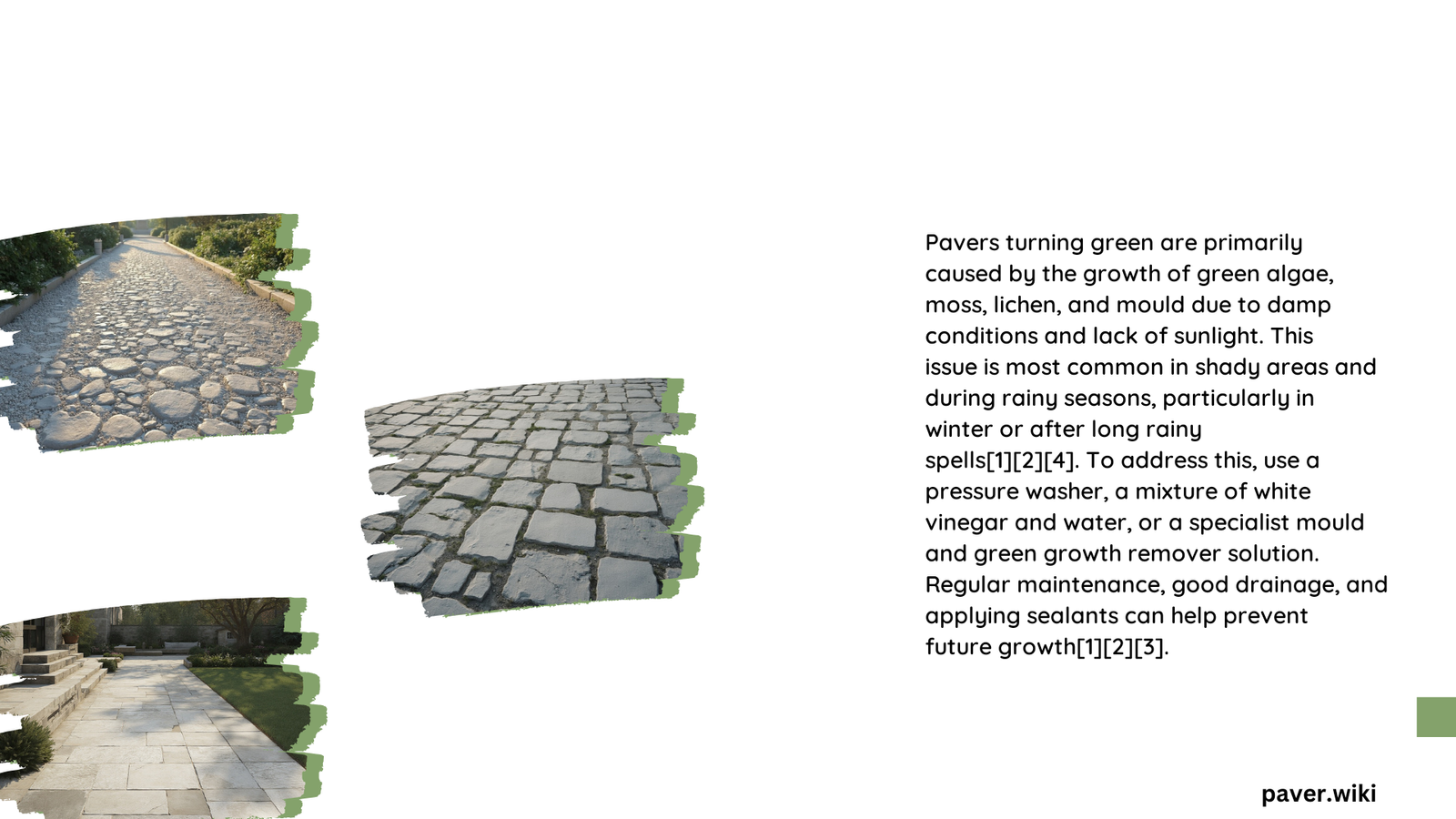Pavers turning green is a common issue faced by homeowners and property managers. This unsightly problem occurs when mold, algae, or moss grow on the surface of pavers, causing discoloration and potential damage. Understanding the causes, effective removal techniques, and preventive measures is crucial for maintaining the aesthetic appeal and structural integrity of your paved surfaces.
Why Are My Pavers Turning Green?
The green discoloration on pavers is typically caused by the growth of algae, moss, or mold. These organisms thrive in damp, shaded environments and can quickly spread across porous surfaces. Several factors contribute to this issue:
- Excess moisture
- Lack of sunlight
- Poor drainage
- High humidity
- Organic debris accumulation
What Environmental Conditions Promote Green Growth on Pavers?
- Humidity: High humidity levels create an ideal environment for algae and mold growth.
- Shade: Areas with limited sunlight exposure are more prone to green discoloration.
- Temperature: Warm temperatures, especially when combined with moisture, accelerate growth.
- Proximity to vegetation: Overhanging trees or nearby plants can increase organic debris and moisture.
How Can I Remove Green Growth from My Pavers?

Removing green growth from pavers requires a combination of cleaning solutions and proper techniques. Here are some effective methods:
-
Pressure Washing: Use a pressure washer to remove surface growth. Be cautious not to damage the pavers or dislodge sand between them.
-
Chemical Cleaners: Apply specialized paver cleaners or a mixture of water and bleach (1:10 ratio) to kill algae and mold.
-
Natural Solutions: Use white vinegar or baking soda paste for an eco-friendly approach.
-
Scrubbing: After applying a cleaning solution, use a stiff brush to scrub the surface thoroughly.
-
Rinsing: Always rinse the pavers thoroughly after cleaning to remove any residue.
What Are the Best Cleaning Products for Green Pavers?
| Product Type | Examples | Pros | Cons |
|---|---|---|---|
| Chemical Cleaners | Wet & Forget, 30 Seconds Outdoor Cleaner | Highly effective, long-lasting | May harm plants, require protective gear |
| Natural Solutions | White vinegar, Baking soda | Eco-friendly, safe for plants | May require more frequent application |
| Oxygen Bleach | OxiClean, Biokleen Oxygen Bleach | Safe for most surfaces, biodegradable | Less effective on stubborn stains |
How Can I Prevent My Pavers from Turning Green?
Preventing green growth on pavers involves addressing the root causes and implementing regular maintenance:
-
Improve Drainage: Ensure proper slope and drainage to prevent water accumulation.
-
Increase Sunlight: Trim overhanging branches to allow more sunlight on the pavers.
-
Regular Cleaning: Sweep and rinse pavers regularly to remove organic debris.
-
Apply Sealant: Use a quality paver sealant to create a protective barrier against moisture and algae growth.
-
Maintain Surrounding Areas: Keep nearby vegetation trimmed and remove fallen leaves promptly.
How Often Should I Clean My Pavers to Prevent Green Growth?
- Routine Cleaning: Sweep and rinse pavers weekly to remove debris.
- Deep Cleaning: Perform a thorough cleaning with appropriate solutions every 3-6 months.
- Resealing: Apply a new coat of sealant every 2-3 years, or as recommended by the manufacturer.
What Are the Long-term Effects of Neglecting Green Growth on Pavers?
Ignoring green growth on pavers can lead to several issues:
- Aesthetic Deterioration: Continued growth can significantly impact the appearance of your outdoor space.
- Structural Damage: Prolonged moisture retention can lead to cracking and erosion of pavers.
- Safety Hazards: Slippery surfaces due to algae growth increase the risk of accidents.
- Costly Repairs: Neglect may result in the need for extensive cleaning or even paver replacement.
How Much Does Professional Paver Cleaning Cost?
Professional paver cleaning services typically charge based on the square footage of the area to be cleaned. Here’s a general price range:
- Small areas (up to 500 sq ft): $200 – $400
- Medium areas (500 – 1000 sq ft): $400 – $700
- Large areas (1000+ sq ft): $700 – $1500+
Prices may vary depending on the severity of the green growth, location, and additional services like sealing.
By understanding the causes of pavers turning green and implementing proper maintenance techniques, you can keep your outdoor surfaces looking clean and attractive for years to come. Regular cleaning, improving drainage, and addressing environmental factors are key to preventing and managing green growth on pavers.
References:
1. https://www.properla.net/how-to-stop-green-mould-and-algae-from-growing-on-your-patio/
2. https://hg.eu/uk/tips/how-to-remove-green-deposits
3. https://www.gothicstone.com/how-to-rid-mold-on-pavers-battle-mother-nature/
